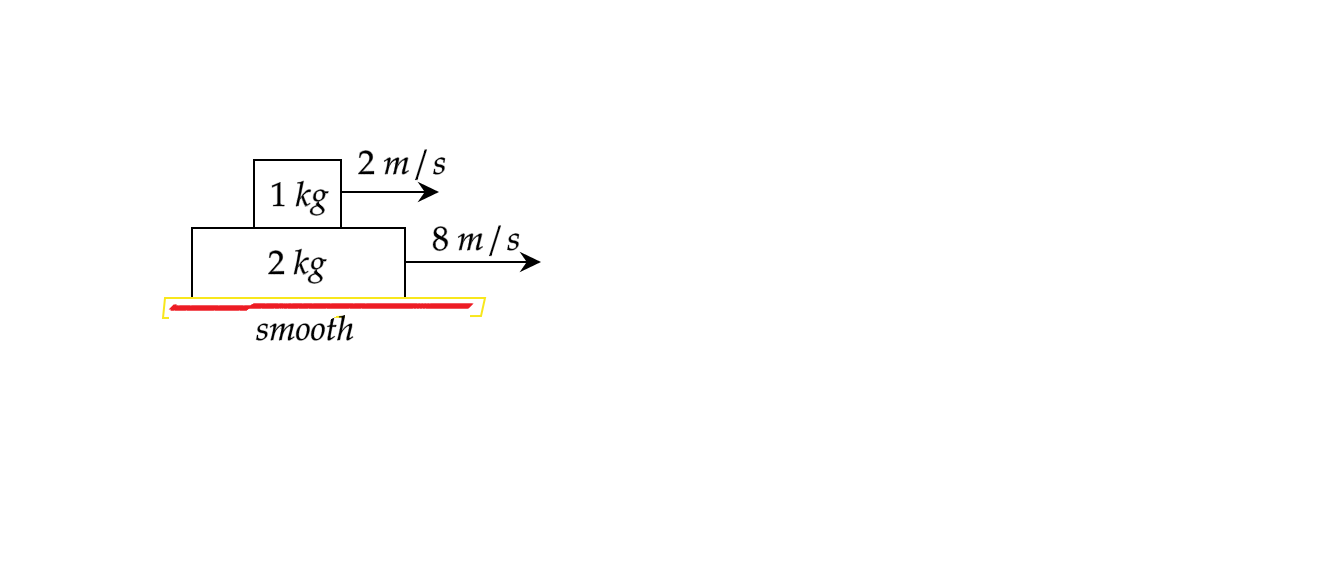Question
Question: Coefficient of friction between two blocks shown in the figure is \[\mu =0.4\]. The blocks are given...
Coefficient of friction between two blocks shown in the figure is μ=0.4. The blocks are given velocities of 2m/s and 8m/s in the direction shown in the figure. Find displacements of 1kg and 2kg blocks up to the instant when the relative motion between the blocks will stop.
(g=10m/s2)

Solution
The relative velocity between the blocks will stop when both the blocks have the same velocity. So if we find the velocity at a certain instant after the start of motion between the blocks and equate them, we can get the time when the relative motion stops. To find the velocity at a certain instant, we need to find the accelerations of the two blocks and hence we must start with the forces acting on the block.
Formula Used:
F=m.a, v=u+at, s=ut+21at2, f=μN
Complete step by step solution:
The floor of the setup is smooth, so no frictional force acts on the 2kg block because of the floor. A friction force will act on the 1kg because the coefficient of friction between the two blocks has been given to us.
From Newton’s law of action and reaction, the reaction of the friction force acting on the 1kg will act on the 2kg block in the opposite direction.
When the relative motion between the two blocks stops, they move together as one single body. This is similar to the inelastic collision of bodies when they stick together after the collision.
So we can apply momentum conservation before and after the relative motion between the blocks stops, which states the sum of the momentum of the blocks before the relative motion stops will be equal to the momentum of the body after the relative motion stops.
Mathematically, we can express it as 1kg×(2m/s)+2kg×(8m/s)=3kg×v where v is the common velocity of the blocks after the relative motion stops.
Solving the above equation, we get v=3kg18kg.m/s=6m/s
Friction force acting one the 1kg block is equal to μN where N is the normal force acting on the block and N=mg
Hence the friction force will be μmg .
Substituting the values, we get f=0.4×1×10=4N
Now, the only force acting on the two blocks will be this friction force of 4N (due to them being an action-reaction pair, as discussed in the hint section)
The friction force tends to oppose the motion of the body and hence, for the 2kg block it acts against its direction of motion. But for the 1kg block, it acts along its direction of motion (since the action must be opposite in direction to the reaction)
Acceleration of the 1kg block is equal to the ratio of the force acting on it to its mass.
Hence, a1=m1f=14=4m/s2 where a1 is the acceleration of the 1kg block.
Similarly, acceleration of the 2kg block (a2)=2kg−4N=−2m/s2. The negative sign implies that the acceleration acts in a direction opposite to the direction of the motion of the block)
Now, we have to find the instant when the relative motion stops. To do that, we simply have to apply the first equation of motion to any of the blocks, that is v=u+at where u is the initial velocity, v is the final velocity, a is the acceleration of the block and t is the time taken.
Applying this equation to the 2kg block, we get
